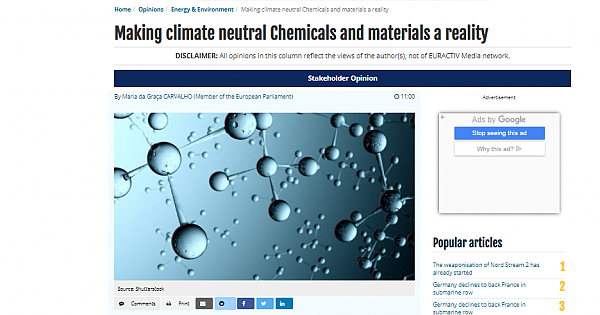Imprensa Making climate neutral Chemicals and materials a reality
The success of the European Green Deal depends on an integrated approach to sustainability and policymaking. Climate and circular economy policies must go hand in hand or risk hampering meaningful progress.
Product-related emissions account for 45% of total emissions, and proposed policies such as the Sustainable Product Initiative and Safe and Sustainable-by-design criteria, show that the Commission has recognised the importance of the environmental footprint of EU products. However, these actions within the current policy framework are not sufficient to reduce greenhouse gas emissions (GHG) associated with the manufacturing of products. In order to deliver on the Paris Agreement and limit global warming to 1.5 degrees, the legislative proposals, as part of Circular Economy Action Plan must be smarter. Notably, they must extend the efforts to reduce carbon emissions beyond the energy used for manufacturing, to encompass all products and the materials they are made of, including chemicals.
Chemicals are everywhere and play a fundamental role in almost everything, contributing to our quality of life. They will also play a fundamental part in the new technologies that will enable our transition to a climate neutral economy. Nevertheless, there is also a climate impact from the carbon embedded in chemicals that has received little policy attention thus far.
For most primary petrochemicals, up to 73% of their carbon footprint results from the carbon embedded in the molecules. This has led to a paradox, where on one hand the production of chemicals is increasingly powered by renewable energy, while fossil fuels remain the prime feedstock to make most chemicals and materials.
Currently, petrochemical feedstock accounts for 12 % of global oil demand. It is rapidly becoming the largest driver of global oil demand and, ahead of trucks, aviation and shipping. It is expected to account for over a third of the growth in oil demand by 2030, and nearly half by 2050.Given that most of the carbon embedded in petrochemicals will naturally end up in the atmosphere (either through incineration or (bio)degradation), as long as fossil carbon remains the main feedstock for chemicals, the problem of global warming will only be exacerbated.
So, how can we meet the growing demand for chemicals in the future whilst decoupling the negative effects intertwined with their production and end-of life disposal? How can we remove or reduce the use of the most carbon intensive chemicals whilst delivering the same performance?
A future based on the circular economy of carbon
The good news is that the solutions are emerging fast. Rapid development in biosciences and catalytic chemistry and their application unlock the use of sources of carbon that are already above the ground. A mix of carbon from recycled or renewable sources can be used to make products – from clothes fibres to detergents. This effectively replaces the use of fossil carbon, which adds to the earth’s carbon burden. Many pioneering companies have plans to launch products using renewable sources of carbon, proving that this is an economically viable solution, and most importantly, significantly better for the environment.
As policymakers, we have a responsibility to empower the innovators and frontrunners that will provide the circular solutions. It is essential that we establish the right framework to ensure that our legislation does not impede but supports the roll out of these new technologies and associated infrastructure.
As such, upcoming policy initiatives like the Sustainable Products Initiative and the Safe and Sustainable-By-Design criteria should recognise the carbon embedded in chemicals and materials through a list of sensible provisions.
Firstly, we need a common, science-based definition of circular carbon, which will set the ball rolling to enable the circularity of materials and chemicals. Furthermore, we will need to establish a roadmap for closed-carbon loops that includes a carbon hierarchy to guide the allocation of carbon according to societal needs and overall environmental impact.
Secondly, existing rules will need to consider the embedded life-cycle CO2 emissions in final products, by setting limits that will decrease overtime. This also means that when assessing the carbon footprint of products and materials, life-cycle assessments must take into account the degradation of chemicals at the end of life, using an appropriate and standardised methodology. In addition, it will be necessary for chemical legislation to better integrate both safety and sustainability dimensions.
Finally, we need to empower the consumer to make ‘greener’ and more sustainable choices. By developing standards for reporting embedded carbon in products, for example, and by presenting this information in a consistent and comparable way, we can better inform consumers while levelling the playing field for companies.
